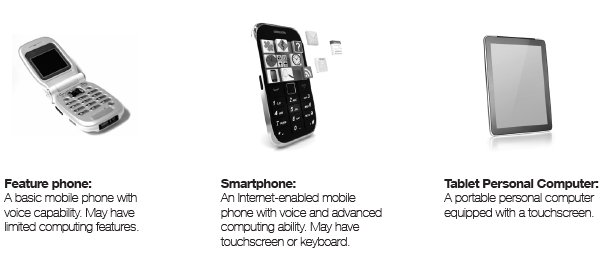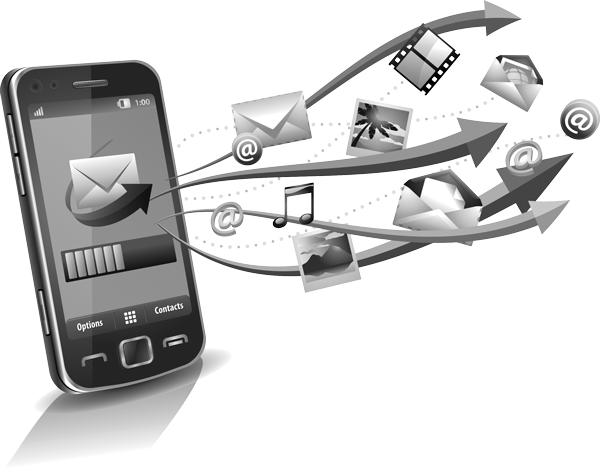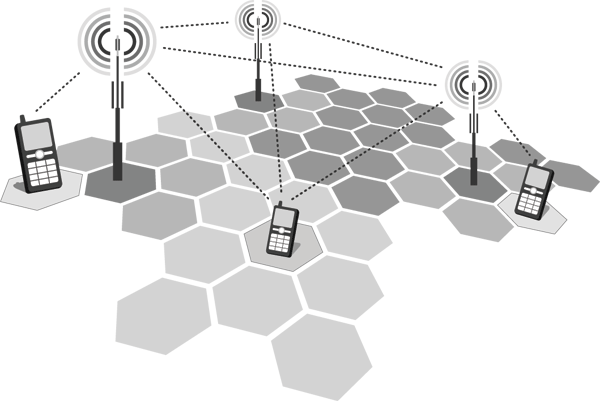Choosing and Using Mobile Devices
This WirelessED publication explains how to select a smartphone or other data-ready wireless device and service plan, monitor and manage your usage, and get the best value for your budget and your needs.

Publication Series
- This publication is part of the WirelessED training module.
Download File
PDF files may contain outdated links.
Choosing and Using Mobile Devices
File Name: wirelessed_devices.pdf
File Size: 0.65MB
Languages Available
Table of Contents
Browsing the Internet … watching a video … sending email on the go are just a few of things you can do with a data-ready mobile device and a data service plan. Being connected has many benefits, but it’s important to know your needs and manage your usage to avoid unanticipated charges. The good news is, there are lots of tools and resources to help you stay in control while enjoying all the benefits your mobile data device offers.
Choosing and using mobile devices
Mobile devices make it possible to work, stay in touch, get information, and enrich our lives on the go. For many of us, smartphones, tablet computers, and the other data-ready mobile devices are an indispensible part of daily life. While these high-tech wireless gadgets have many benefits, it is important to clearly understand the financial commitment involved in the purchase and use of these devices. By understanding how to select the right device and service plan to best meet your individual needs and how to monitor and manage your usage, you’ll be able to get best value for your budget and your needs.

‘Smart’ devices
Generally speaking, Internet-enabled mobile devices have a display screen, a miniature keyboard or touchscreen, and the ability to access the Internet.
Some of the most popular mobile devices are smartphones. Smartphones have unique software called operating systems, which are just like computers. Mobile operating systems include Apple (iPhone), RIM (Blackberry), Android, and Microsoft. Devices with mobile operating systems can send and receive email, browse the Internet, stream music and video, upload and download files, play games, and do many of the other things a full-size computer can do. Smartphones can also use “apps,” which are mobile software applications specially designed for wireless devices.
To take advantage of all the features and functions of these different mobile devices, you must have a wireless data plan, in addition to any voice or text plan you may have.
Typically, data, voice, and text plans are sold separately.
Devices and service contracts
Many wireless carriers offer discounts or other promotional deals on phones if you sign up for a long-term service contract of one or two years. The cost of these devices can vary—anywhere from free for the simplest voice-and-text-only phone to a couple hundred dollars for the most sophisticated smartphone. Offers may differ in stores and online even at the same carrier, so shop around.
Avoid the temptation to buy more device than you need. The data service plans needed to activate the more sophisticated devices will be an ongoing expense.
When choosing a phone, consider not just cost, but size, weight, battery life, features, and capabilities. If you plan to use your phone abroad, consider a model that uses GSM (global system for mobile communications) technology. If you plan to send a lot of e-mail, look for a comfortable keyboard. Accessories such as a hands-free headset or a carrying case usually cost extra.
As a wireless customer, you may be eligible for a new phone from time to time. Most carriers offer customers the chance to get a new, discounted device periodically. Check with your carrier to find out its equipment upgrade policy. If you purchase a new phone at a promotional price prior to the end of any applicable term agreement, you may be required to extend your contract.
In addition, if you switch carriers, you may have to get a new phone since some devices only work on certain networks. (Old phones can be donated
to charities or recycled.)
http://www.epa.gov/osw/partnerships/plugin/cellphone/
http://www.cellphonesforsoldiers.com

Buying your own
You don’t have to get your phone or data-ready device through your carrier. You can buy it from a big box retailer like Walmart, nationwide electronic chains like Radio Shack, online vendors like eBay, and elsewhere. These sources might offer additional models, although prices may be higher without a carrier rebate or discount. Make sure that any device you purchase from a non-carrier source will work on your carrier’s network. Ask the seller if there is a period during which you can return or exchange a new device.
Optional Services
Most devices come with a one-year manufacturer’s warranty. You might be offered an extended warranty, an optional service that replaces your device if it stops working due to a manufacturer’s defect. Before purchasing an extended warranty, read the fine print, as it contains important limits and exclusions to coverage.
Another optional service, phone insurance, replaces a mobile phone that is lost, damaged, or stolen. While the coverage might provide some peace of mind, it is important to note that premiums range from about $4 to $8 per month. Reimbursements usually require you to pay a deductible of anywhere from $25 to $125, depending on the phone model. And policies typically state that replacement phones can be refurbished rather than new, may be a different brand, model, or color than the old phone, and may not be compatible with your current accessories.
Wireless Service
Wireless carriers offer a variety of popular phones and plans with similar features, although specific rates, service packages, cancellation
fees, and other terms vary.
Here are some common types of wireless service plans:
- Unlimited plans—You pay a flat monthly price for all the voice, messaging, or data you can use in a month. Voice, messaging, and data plans are sold separately.
- Usage-based—You buy a package (bucket) of service for a monthly charge. For example, you might get 1,000 voice minutes for $29.99, or 450 voice minutes, unlimited text messages, and 200 MB of data for $69.99. If you go over your plan allowance, additional usage is billed at a per-unit rate. Some carriers or plans allow you to carry over unused voice minutes (but not text or data allowances) to the following month.
- Family plans—These plans include a certain number of voice minutes, text messages, and/or data service that can be shared among multiple devices on the account. Often, calls and texts between family members (mobile-to-mobile) don’t count against plan allowances.
- Nationwide plans—A nationwide plan makes the entire continental U.S. your calling region. In other words, you won’t be assessed long distance or roaming charges. The monthly rate for these plans may be higher.
- Prepaid plans—These plans do not require a credit check or fixed-contract term. There’s no monthly bill since you pay for service before you use it, although some plans may require you to purchase additional service at regular intervals. Once you have used up your balance, you can’t use your phone until you buy additional service time. Your balance may expire if you don’t use it within a given period.
- International plans—These plans are designed for consumers who want to call and send text messages to other countries from the U.S. or for travelers who want to use their phones while traveling abroad. You might be able to purchase a flat-rate plan that provides a minute, message, and data allowance, or one that entitles you to lower per-minute and per-message rates for a monthly fee.
Plans are available on a month-to-month basis, but buying a new device at a discount will sometimes require a two-year service contract.
Most carriers offer a trial period that allows you to cancel without penalty within a specific period of time (usually two to four weeks). If you decide to cancel after the trial period is over, you will incur an early termination fee (ETF) that could be $250 or more. If you return your device within this period, you may be asked to pay a “re-stocking” fee. If you received a rebate for your device, you may be refunded the purchase price less the rebate amount.
TIP
If your phone is lost or stolen, notify your carrier right away so that service can be turned off to avoid unauthorized use, for which you may be liable.
Device Data Requirements
You typically use more data functions and access the Internet when you own a smartphone, and this activity can be expensive if you pay for data on a pay-per-use basis and do not subscribe to a data plan or if you are traveling internationally outside of your carrier’s network coverage.
The amount of data you use depends mainly on how you use your device. For example, someone who streams music or videos every day will use much more data than someone who only sends and receives the occasional email. The more sophisticated your phone, the more data it will use.
Apps use data when you download them—anywhere from five to 80 megabytes, depending on the app. Web-based apps continue to use data to operate as they connect to the Internet automatically to get updates and retrieve information. Examples include weather and stock market updates and email programs. For more information, see “Using Data Wisely” on the WirelessEd.org website.
Monitoring usage
Customers of all major carriers can check their usage at any time by visiting the company’s website. And some carriers send text alerts as you approach your service limits or once you begin incurring overage charges.
You also can get usage information right on your device. With phones you dial a certain code, which varies based on provider, to receive a text message or voice recording from your carrier with usage data. Or you can check the device’s usage meter under the general settings menu. (Reset it at the beginning of each billing cycle for an accurate count.)
Other tools range from apps that alert you if your data usage reaches a predetermined level to widgets (helper tools) that enable you to monitor
your usage as you go.
Parental control tools are available to help manage which family members are able to buy apps, games, and other purchases using a data-ready device. All major carriers offer parental controls, which typically allow parents to set limits on children’s usage (including downloads of games, ringtones, graphics, and applications), filter incoming and outgoing data, limit features (such as picture messaging), and block certain sites. Discuss your needs with your carrier.
Wireless network vs. Wi-Fi
With most data-enabled devices, you can get data service on your carrier’s network or via Wi-Fi. WiFi is simply wireless service using different radio frequencies to transmit and receive data that are different than the frequencies used by your service provider. Thus, Wi-Fi lets you do all the same things that your wireless service provider does, without using data from your plan bucket.
If you don’t have an unlimited data plan, you can save money by putting your device on the Wi-Fi setting instead of your wireless network. (Leaving Wi-Fi on permanently uses battery power, so turn it off whenever you don’t need it.)
Wi-Fi isn’t everywhere, but you can find it in many hotels, airports, cafes, and other public spaces, called “hotspots.” You also can use Wi-Fi at your home or workplace, if available.

Published / Reviewed Date
Published: April 12, 2011
Download File
Choosing and Using Mobile Devices
File Name: wirelessed_devices.pdf
File Size: 0.65MB
Sponsors
AT&T
Notes
Created by Consumer Action with the sponsorship of AT&T.
Filed Under
Copyright
© 2011 –2024 Consumer Action. Rights Reserved.



